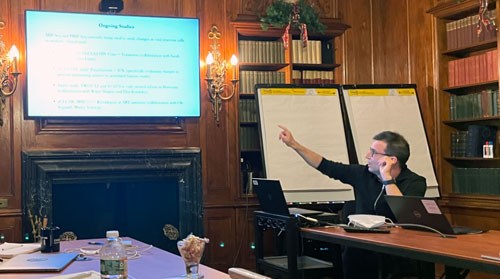Can Long-Term Treatment Lead to ART-Free Control of HIV?
By Rowena Johnston, Ph.D.
Background
In early December 2021, amfAR convened a think tank of 15 researchers to address this tantalizing possibility. The question follows on the heels of a number of recent findings made by Drs. Xu Yu of the Ragon Institute of MGH, MIT and Harvard, and Mathias Lichterfeld of Brigham and Women’s Hospital in Boston, who attended the think tank.
In August 2020, Drs. Yu and Lichterfeld reported in the prestigious journal Nature on the case of a woman diagnosed with HIV in 1992, who for all intents and purposes may be thought of as “cured” of HIV. The woman had never taken antiretroviral therapy (ART) and was thus considered an elite controller, one of the very rare individuals who control their HIV without ever needing therapy.
In closely examining blood and tissue samples taken from the woman, the researchers discovered that vestiges of HIV were locked inside “gene deserts,” regions of the genome where the virus remains tightly locked down and unable to replicate (read more). Then in 2021 they reported on a similar case, describing a woman in Argentina who was diagnosed with HIV in 2013 but who likewise showed no sign of any HIV capable of replicating (read more).
In their studies, Yu, Lichterfeld and colleagues described other elite controllers with a preponderance of virus locked into regions of the DNA from which HIV is unlikely to emerge. There are compelling reasons to believe this is the result of an active and ongoing immune response against the virus. The hypothesis proposes that cells that harbor viruses that actively make copies of themselves alert the immune system, which promptly kills those cells. Meanwhile, cells harboring virus in locked-down regions produce no offspring viruses and thus nothing for the immune system to detect and destroy. These findings raise the intriguing possibility that similar immune processes are ongoing in other people living with HIV (PWH), at various speeds and with varying levels of effectiveness.

(Photo: Jon Cohen)
Think tank
amfAR convened its December think tank to thoroughly investigate this phenomenon and to determine what more might be learned about these controllers and the mechanisms that enable them to naturally suppress HIV. The think tank was subsequently featured in a story in Science magazine in January 2022.
Scientists at the think tank presented what is known about the ability to control HIV without ART in a range of PWH, including elite controllers as well as post-treatment controllers—people who took ART for a number of years then stopped without experiencing viral rebound. A variety of potential immune mechanisms were discussed, and numerous methods for measuring HIV in its various locations and states of replication-competence were also covered.
The discussion came around to two very important questions. How common is this phenomenon of whittling down the HIV reservoir until it remains only in locations that render it impotent? And how can we speed up the process and compel it to occur in other—and perhaps all—PWH?
Future Directions
Coming out of the think tank, amfAR is currently investigating the exciting possibility that some people who have taken ART for many years may, unbeknownst to them, have cleared the virus and no longer need treatment. This can only be studied under closely supervised and intensely monitored conditions by investigators with the tools to navigate these complex questions. We look forward to reporting on future progress
Dr. Johnston is an amfAR vice president and director of research.
Share This:
